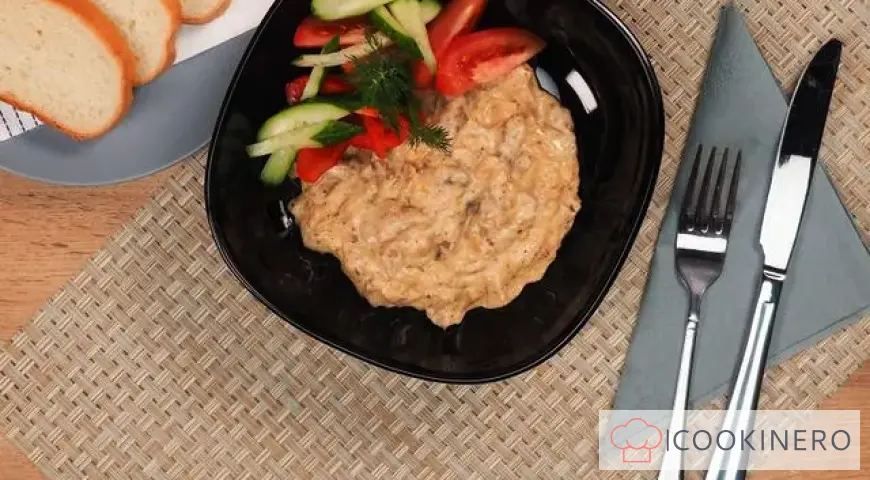Kulich "Davydovsky" from Elena Bon

Such a yeast dough cake with candied fruits (or dried apricots) and walnuts, with raisins soaked in cognac, with a pleasant vanilla aroma and a nutty tinge in taste, moderately sweet, with crispy protein glaze, light and low-fat, soft and airy, I cook for Easter according to the recipe shared with me by the mother of my youngest daughter's classmate and my good friend, Natasha Davydova. Hence the name attached to it. True, I slightly changed the technology of its preparation. PS For baking for this amount of dough, you will need 5 disposable special baking forms made of waxed paper Ø 13 cm and 10 cm high with a volume of 400 g of dough or others that you have in stock of a similar volume. From the indicated amount of ingredients, 5 Easter cakes weighing 450 g each or 4 each 500 + 1 weighing 430 g are obtained.
How to cook Kulich "Davydovsky" from Elena Bon
Step 1

Remove the butter in advance (2-3 hours before kneading the dough) from the refrigerator so that it becomes very soft, creamy, or soften it in the microwave immediately before cooking. Before preparing the dough, measure the required amount of raisins, rinse it first with warm, then cold water, then dry it a little on a napkin and put it in a small container. Pour 50 ml of cognac, cover with a lid or foil (so that the cognac does not erode) and set aside until use.
Step 2

Measure the required amount of flour with salt and granulated sugar into separate containers. In ordinary granulated sugar, add the pulp of a vanilla pod or vanilla sugar or vanillin.
Step 3

Measure the amount of milk required according to the recipe and heat in a saucepan or aluminum bowl over low heat until warm (about 40 ° C). Crumble fresh or dry yeast into it and let it get wet for about 5 minutes.
Step 4

At this time, weigh and cut into medium pieces walnuts and candied fruits. If you use dried apricots in the recipe, then rinse it with warm and cold water, dry it on a paper towel, and then cut it into small cubes. Sprinkle nuts and candied fruits (or dried fruits) with 1 tbsp. l. flour from the total amount measured earlier, and mix well.
Step 5

Break the eggs into a large (at least 3.5 liters) container for kneading the dough and beat with a mixer with ordinary whisks into a fluffy foam, then add ½ of the previously measured granulated sugar with vanilla (or vanillin) to them, beat and add the rest of the sugar. Again, beat everything until fluffy.
Step 6

Pour milk with yeast over the eggs, while scraping their remains from the walls of the container. Mix with mixer on medium speed.
Step 7

In 2-3 doses, add 500 g of previously measured flour with salt to the dough, after sifting it through a sieve (do not forget to pour salt crystals from the sieve into the dough if they get stuck in the sieve). Mix everything thoroughly to get rid of lumps, and add the softened butter.
Step 8

Mix the contents of the container again until smooth so that the oil is evenly distributed in the dough, and change the beaters on the mixer to beaters for yeast dough.
Step 9

In portions (in 2-3 doses), add another 500 g of flour to the dough, also sifting and mixing it each time with a mixer at low speed. After that, collect the remaining flour from the edges of the bowl and mix everything again.
Step 10

Throw the previously soaked raisins in a colander (save the cognac), squeeze lightly and fold over nuts and candied fruit. Sprinkle 1 tbsp. l. from the remaining flour, mix so that the raisins are covered with flour.
Step 11

Add the cognac in which the raisins were soaked to the dough and slowly and carefully mix it with a mixer at low speed (the liquid may splatter).
Step 12

Enter candied fruits and nuts into the dough along with the flour in which you rolled them. Add the rest of the flour to the dough, sifting, and finally knead everything, while reaching the bottom of the container with the whisks of the mixer. The dough will be slightly sticky to the beaters and hands. Transfer the finished dough (preferably using a special silicone spatula or scraper) into a large saucepan (about 4-5 liters in volume), level its surface, cover with plastic wrap and put in the refrigerator for proofing for 10-12 hours (but not more than 18- 24).
Step 13
On the day of baking Easter cakes, remove the pan with the dough from the refrigerator, changing the film on it (so that condensation does not drip onto the dough) and, without lowering it, let it warm at room temperature for about 2.5-3 hours. Turn on the oven and heat it to 3-3.5 (about 170-190 ° C) or in accordance with the recommendations in the instructions for your oven for baking yeast dough. If necessary, first lower the rack in the oven one level from the middle, focusing on the height of the forms, and also taking into account that the Easter cakes will increase during baking.
Step 14

While the dough is warming, prepare the molds: if you are using aluminum molds, grease them with odorless vegetable oil and sprinkle with flour. Or, having lubricated them with oil, you can line their bottom and sides with parchment for baking (preferably to a height twice as high as the height of the form - so that the cake does not “escape” during the baking process), in this case it is not necessary to sprinkle the forms with flour. If you have purchased paper molds made from special non-stick paper, you do not need to lubricate and sprinkle them with something.
Step 15

Lower the warmed dough (knead it) and, dusting your hands with flour, spread it out according to the existing forms (filling them no more than ⅓-½). At the same time, it is advisable to roll each piece of dough into a ball a little, so that the finished Easter cakes turn out to be neater. Usually I distribute the dough using 500 g scales into 4 forms (so the finished cakes will be taller, with a “cap”), and put the rest (weighing about 430-450 g) into the remaining last form.
Step 16

Place the molds on one or more baking sheets (if possible so that they do not touch each other). Cover the top of the molds with a regular cloth or paper towel or plastic wrap (see photo) and let the dough rise in a warm place (no drafts) and rise to ¾ of the height of the molds or a little higher. This may take about 1.5-2 hours. It is advisable to periodically rotate Easter cakes around their axis so that they rise more evenly.
Step 17

When the dough rises well and its volume increases, separate the yolk from the protein (manually or using a separator) from the egg (necessarily fresh, pre-washed with soap and warm water), trying to prevent particles of the first from getting into the protein, otherwise it will not fluff up as needed. Remove the protein in a tightly closed container in the refrigerator - it will be possible to make icing for Easter cakes from it the next day. And beat the yolk with a whisk with 1 tsp. milk and gently, almost without pressing, brush it with a culinary brush on the “caps” of Easter cakes. Then, trying not to shake them, put the cakes in the oven.
Step 18

Bake Easter cakes at the number 3-3.5 (about 170-190 ° C) for 45-50 minutes or in accordance with the recommendations from the instructions for your oven for baking yeast dough. If you use small paper forms for 200 g of dough, then about 30 minutes. The readiness of Easter cakes can be determined by piercing them with a wooden stick - if the dough does not stick to it, the Easter cake is ready. Try not to slam the oven door when checking or removing Easter cakes, as this can cause them to settle.
Step 19
Carefully remove the finished Easter cakes from the oven, cover with paper towels and let them cool right on the baking sheet at room temperature, and preferably in a warm place (for example, on the oven), protecting from drafts. After a couple of hours, remove the slightly cooled Easter cakes from the aluminum molds (if you used them) and lay them on their side on a soft surface, such as a pillow (laying a clean cloth or paper napkin on it, and the other one covering the cakes from above), so that the top of the cake is slightly higher than its base. From time to time roll them from side to side - this is necessary so that the crumb of the cake is as airy as possible. For Easter cakes in paper forms, this is not necessary: just leave them on a baking sheet until they cool completely.
Step 20
Easter cakes should cool completely and stand a little - about 20-24 hours after baking. If you removed them from aluminum molds, carefully cut off the burnt places (if any) from them with a sharp knife with a serrated blade (for cutting bread) with sawing movements. I do not remove paper molds until the very use of baking.
Step 21

Now the cakes can be decorated. If you plan to use walnuts for this, they need to be heated in a pan (for example, in a preheated oven for about 5 minutes), cool and chop coarsely with a knife, then rub in your hands until oily. Candied fruits, if desired, can be cut into small cubes or left in long sticks.
Step 22

For the icing, beat the protein saved earlier (see item 17) with a whisk of a mixer into a stable foam, then gradually add granulated sugar and lemon juice to it in portions (in 2-3 doses). Beat the mass until persistent peaks appear on the whisk - see photo. With a spoon, spread the finished icing over the "hats" of Easter cakes.
Step 23

Immediately, while the icing has not yet hardened, decorate the “caps” of Easter cakes with candied orange, coarsely chopped walnuts. If you use ready-made sugar or waffle flowers or colored confectionery topping, it is advisable to let the glaze dry for 6-12 hours at room temperature before applying them.
Step 24
Let the glaze dry for at least 12-24 hours at room temperature, without covering. Be careful - until the glaze has hardened, any touch will leave marks on it.
Step 25

After the consecration, Easter cakes are eaten at the festive Easter table. Usually they are cut as follows: after cutting off the “cap” (the top with icing) and putting it aside, the crumb is cut into horizontal layers, each of which is then divided into 4 or more parts. And then the remnants of the Easter cake are covered with a deferred "cap". The very top is eaten last, thus trying to keep the festive appearance of the cake for as long as possible. But you can, of course, cut the Easter cake like a regular cake - into vertical segments (this is especially true for small Easter cakes). Ready-made Easter cakes can be stored at room temperature, covered with a paper towel, for 7-10 days. Over time, their crumb will dry out and become crispy and crumbly, but no less tasty than fresh.
Kulich "Davydovsky" from Elena Bon - FAQ About Ingredients, Baking Time and Storage
Reviews: 0
0 Overall ratingHave you already prepared this recipe? Tell what you think.






